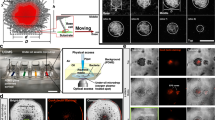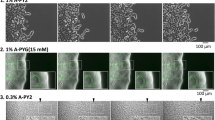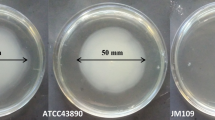Abstract
IT has been suggested that1,2 EDTA disaggregates cells by removing divalent cations from the electrostatic double layer, increasing the surface potential and thus the electrostatic repulsive force between cells. This hypothesis has never received confirmatory evidence and recent work has cast doubt on its validity3–6. We have used post-feeding cells of the cellular slime mould, Dictyostelium discoideum, to demonstrate that EDTA does not act through an increase in average electrostatic repulsive force. But in other conditions these forces seem to be important in determining whether or not the cells can adhere7.
This is a preview of subscription content, access via your institution
Access options
Subscribe to this journal
Receive 51 print issues and online access
$199.00 per year
only $3.90 per issue
Buy this article
- Purchase on Springer Link
- Instant access to full article PDF
Prices may be subject to local taxes which are calculated during checkout
Similar content being viewed by others
References
Curtis, A. S. G., Biol. Rev., 37, 82 (1962).
Curtis, A. S. G., The Cell Surface: Its Molecular Role in Morphogenesis (Academic Press, New York, 1967).
Weiss, L., J. Cell Biol., 33, 341 (1967).
Weiss, L., J. Cell Biol., 35, 347 (1967).
Armstrong, P. B., J. Exp. Zool., 155, 371 (1966).
Armstrong, P. B., and Jones, D. P., J. Exp. Zool., 167, 275 (1968).
Born, G. V. R., and Garrod, D., Nature, 220, 616 (1968).
Sussman, M., in Methods in Cell Physiology (edit. by Prescott, D. M.), 2, 397 (Academic Press, New York, 1966).
Ashworth, J. M., and Sussman, M., J. Biol. Chem., 242, 1969 (1967).
Abramson, H. A., Moyer, L. S., and Gorin, M. H., Electrophoresis of Proteins and the Chemistry of Cell Surfaces (Reinhold Publishing Corporation, New York, 1942).
Pethica, B. A., Exp. Cell Res., suppl. 8, 123 (1961).
Gingell, D., and Palmer, J. F., Nature, 217, 98 (1968).
Author information
Authors and Affiliations
Rights and permissions
About this article
Cite this article
GINGELL, D., GARROD, D. Effect of EDTA on Electrophoretic Mobility of Slime Mould Cells and its relationship to Current Theories of Cell Adhesion. Nature 221, 192–193 (1969). https://doi.org/10.1038/221192a0
Received:
Issue Date:
DOI: https://doi.org/10.1038/221192a0
Comments
By submitting a comment you agree to abide by our Terms and Community Guidelines. If you find something abusive or that does not comply with our terms or guidelines please flag it as inappropriate.



